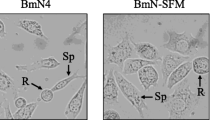Abstract
Expression of c-jun gene induces apoptosis ofcells cultured in serum-free medium. It also promotescell-cycling in serum-containing medium, leading cellsto die by overgrowth. Previously, we established anapoptosis-suppressible, cell-cycle arrestable cellline, c-jun AS, by transfecting Friend murineerythroleukemia (F-MEL) cells with adexamethasone-inducible antisense c-jun gene.Induction of the antisense c-jun transcriptionwith dexamethasone suppressed c-jun expression.As a result, c-jun AS cells survived inserum-free medium containing dexamethasone for a longtime, while F-MEL cells died quickly in the presenceor absence of dexamethasone. In serum-containingmedium, the growth of c-jun AS cells was viablyblocked by inducing antisense c-juntranscription, and the cells survived at thenon-growth state avoiding overgrowth. In the presentstudy, protein productivity of c-jun AS cellswas examined in comparison with that of wild typeF-MEL cells. C-jun AS and F-MEL cells werefurther transfected with a vector for expressingalkaline phosphatase as a protein to be produced, andnamed c-jun AS-SEAP and F-MEL-SEAP cells,respectively. In the serum-free medium withdexamethasone, c-jun AS-SEAP cells produced theprotein for up to 6 days, while F-MEL-SEAP cellsstopped production on day 3 due to cell death causedby serum deprivation. In the serum-containing mediumwith dexamethasone, c-jun AS-SEAP cells wereviably arrested in the cell cycle, and cell death dueto overgrowth was avoided. As the result, they couldproduce the protein for up to 18 days, whileF-MEL-SEAP cells stopped production within 7 days dueto cell death caused by overgrowth.
Similar content being viewed by others
References
Anderson AJ, Pike CJ & Cotman CW (1995) Differential induction of immediate early gene proteins in cultured neurons by beta-amyloid (A beta): association of c-Jun with A beta-induced apoptosis. J Neurochem 65: 1487–1498.
Colotta F, Polentarutti N, Sironi M, & Mantovani A (1992) Expression and involvement of c fos and c-jun protooncogenes in programmed cell death induced by growth factor deprivation in lymphoid cell lines. J Biol Chem 267: 18278–18283.
Estus S, Zaks WJ, Freeman RS, Gruda M, Bravo R & Johnson Jr EM (1994) Altered gene expression in neurons during programmed cell death: identification of c-jun as necessary for neuronal apoptosis. J Cell Biol 127: 1717–1727.
Franek F & Chladkova-Sramkova K (1995) Apoptosis and nutrition: Involvement of amino acid transport system in repression of hybridoma cell death. Cytotechnology 18: 113–117.
Glacken MW, Adema E & Sinskey AJ (1988) Mathematical descriptions of hybridoma culture kinetics: I. initial metabolic rates. Biotechnol Bioeng 32: 491–506.
Kim YH, Iida T, Fujita T, Terada S, Kitayama A, Ueda H, Prochownik EV & Suzuki E (1998) Establishment of an apoptosisresistant and growth-controllable cell line by transfecting with inducible antisense c-Jun gene. Biotechnol Bioeng 58: 65–72.
Mercille S & Massie B (1994) Induction of apoptosis in nutrientdeprived cultures of hybridoma and myeloma cells. Biotechnol Bioeng 44: 1140–1154.
Rampalli AM & Zelenka PS (1995) Insulin regulates expression of c-fos and c-jun and suppresses apoptosis of lens epithelial cells. Cell Growth Differ 6: 945–953.
Sawai H, Okazaki T, Yamamoto H, Okano H, Takeda Y, Tashima M, Sawada H, Okuma, M, Ishikura H, Umehara H & Domae N (1995) Requirement of AP-1 for ceramide induced apoptosis in human leukemia HL-60 cells. J Biol Chem 270: 27326–27331.
Singh RP, Al-Rubeai M, Gregory CD & Emery AN (1994) Cell death in bioreactors: role for apoptosis. Biotechnol Bioeng 44: 720–726.
Smith MJ & Prochownik EV (1992) Inhibition of c-jun causes reversible proliferative arrest and withdrawal from the cell cycle. Blood 79: 2107–2115.
Soprano KJ, Cosenza SC, Yumet G & Soprano DR (1992) Use of antisense oligomers to study the role of c-jun in G1 progression. Ann N Y Acad Sci 660: 231–239.
Suzuki E & Ollis DF (1990) Enhanced antibody production at slowed growth rates: experimental demonstration and a simple structured model. Biotechnol Prog 6: 231–236.
Takahashi K, Terada S, Ueda H, Makishima F & Suzuki E (1994) Growth rate suppression of cultured mammalian cells enhances protein productivity. Cytotechnology 15: 54–64.
Takahashi K (1996) Methods of controlling growth rate of animal cells cultured for protein production. Ph.D. thesis, University of Tokyo, Tokyo, Japan.
Tohyama N, Karasuyama H & Tada T (1990) Growth autonomy and tumorigenicity of interleukin-6–dependent B cells transfected with interleukin-6 cDNA. J Exp Med 171: 389–400.
Turner R & Tijlan R (1989) Leucine repeats and an adjacent DNA binding domain mediate the formation of functional cFos-cJun heterodimers. Science 243: 1689–1694.
Vomastek T & Franek F (1993) Kinetics of development of spontaneous apoptosis in B cell hybridoma cultures. Immunol Lett 35: 19–24.
Author information
Authors and Affiliations
Corresponding author
Rights and permissions
About this article
Cite this article
Kim, Y.H., Kitayama, A., Takahashi, M. et al. Establishment of an apoptosis-suppressible,cell-cycle arrestable cell line and its applicationfor enhancing protein production of serum-free or-supplemented culture. Cytotechnology 32, 125–134 (2000). https://doi.org/10.1023/A:1008149218360
Issue Date:
DOI: https://doi.org/10.1023/A:1008149218360




